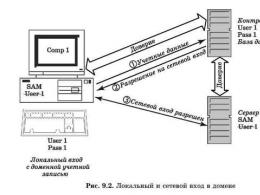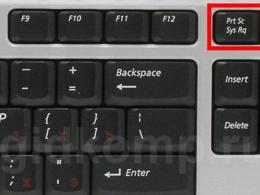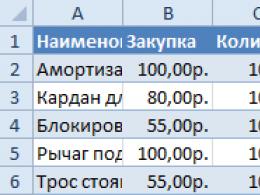How to make transparency in corel. How to make a transparent background in Coreldraw Opacity in Corel
Simple answers to simple questions. How to achieve transparency effect in the program Corel Draw? Without going into the wild vector graphics and assuming that since you're interested this question then you know exactly what Corel Draw, know how to turn it on and create a clean file, let's get down to business. For our experiments with transparency in Corel, I created a simple element - a logo from my site. And although our note on transparency, I will briefly describe how I drew it. Using the tool Ellipse I drew a circle. To make the circle proportional, I held ctrl. Then I filled it with green and gave it a 10pt stroke, which I also filled with dark in gray. Next, on top of the circle, I wrote the text using Text Tool. Scaled, selected font, changed line spacing and kerning between letters. For these manipulations, I used the tool shape tool. Next, I selected both objects, the text chunks and the circle, and grouped them Arrange > Group (Ctrl+G) So I got our logo, and now to transparency.
Transparency in Corel Draw with Transparancy
- Select your object with the tool Pick Tool
- Move it higher and resize if necessary.
- Make a duplicate of the object. Select Edit>Copy, and then Edit > Paste. More operational way shortcuts. ctrl+c to copy and ctrl+v for paste. An even faster way: click on the object with the tool Pick Tool and start as if moving it to another place. After moving, do not release the left mouse button, but click on the right one. The object will be copied.
- Place it below and turn over.

- Choose a tool Trancparancy. This tool hides in the tool tab BlendTool. Hold the instrument for a while for a drop-down menu to appear.
- Click on the bottom emblem and without releasing the mouse button drag the pointer down. White square means full visibility, black, full invisibility. Accordingly, a gradient is obtained between them from visible to invisible, which is regulated by a dash in the middle. To drag the translucency gradient perpendicularly click ctrl while dragging.

 And so we make a translucent gradient in Corel Draw.
And so we make a translucent gradient in Corel Draw.
Transparency in Corel Draw with Lens
Consider transparency with a lens. I want to embed an object in the likeness of waves. I created a semblance of waves from five circles and a rectangle, which I combined with the command Arrange > Shaping > Weld You can use any other object like regular rectangle. Draw it with the tool Rectangle Tool and place on below emblems Arrange > Order > To Back

- Copy the wavy rectangle and place it above the emblem.
- Thus, from the bottom up, we have: waves, an emblem, a copy of the waves, partially covering the emblem. We will apply invisibility to it.
- As you can see, I slightly modified the upper waves, lowered them lower, moved them, stretched them and colored them in a different color.

- Go to Effects > Lens or in Windows > Dockers > Lens In Corel Draw, the same thing can be found in different places.
- A panel for creating lens effects will appear. Select the upper waves with the tool Picker
- In the docker menu lens select Transparency. In meaning Rate 50% and apply

And this is how transparency is done in the Corel Draw program. My advice is don't go overboard with transparencies like this through the lens panel. The program will seriously freeze. The main catch with transparency in Kohler is that transparency remains really transparent only in Korel. When exporting PDF, Corel only imitates transparency, creating a special object that imitates its colors, or simply rasterizes a piece of graphics.
Simple answers to simple questions. How to achieve transparency effect in the program Corel Draw? Without going into the wilds of vector graphics and assuming that since you are interested in this question, then you know exactly what Corel Draw, know how to turn it on and create a clean file, let's get down to business. For our experiments with transparency in Corel, I created a simple element - a logo from my site. And although our note on transparency, I will briefly describe how I drew it. Using the tool Ellipse I drew a circle. To make the circle proportional, I held ctrl. Then I filled it with green and gave it a 10pt stroke, which I also filled with dark gray. Next, on top of the circle, I wrote the text using Text Tool. Scaled, selected font, changed line spacing and kerning between letters. For these manipulations, I used the tool shape tool. Next, I selected both objects, the text chunks and the circle, and grouped them Arrange > Group (Ctrl+G) So I got our logo, and now to transparency.
Transparency in Corel Draw with Transparancy
- Select your object with the tool Pick Tool
- Move it higher and resize if necessary.
- Make a duplicate of the object. Select Edit>Copy, and then Edit > Paste. More efficient shortcuts. ctrl+c to copy and ctrl+v for paste. An even faster way: click on the object with the tool Pick Tool and start as if moving it to another place. After moving, do not release the left mouse button, but click on the right one. The object will be copied.
- Place it below and turn over.

- Choose a tool Trancparancy. This tool hides in the tool tab BlendTool. Hold the instrument for a while for a drop-down menu to appear.
- Click on the bottom emblem and without releasing the mouse button drag the pointer down. White square means full visibility, black, full invisibility. Accordingly, a gradient is obtained between them from visible to invisible, which is regulated by a dash in the middle. To drag the translucency gradient perpendicularly click ctrl while dragging.

 And so we make a translucent gradient in Corel Draw.
And so we make a translucent gradient in Corel Draw.
Transparency in Corel Draw with Lens
Consider transparency with a lens. I want to embed an object in the likeness of waves. I created a semblance of waves from five circles and a rectangle, which I combined with the command Arrange > Shaping > Weld You can use any other object like regular rectangle. Draw it with the tool Rectangle Tool and place on below emblems Arrange > Order > To Back

- Copy the wavy rectangle and place it above the emblem.
- Thus, from the bottom up, we have: waves, an emblem, a copy of the waves, partially covering the emblem. We will apply invisibility to it.
- As you can see, I slightly modified the upper waves, lowered them lower, moved them, stretched them and colored them in a different color.

- Go to Effects > Lens or in Windows > Dockers > Lens In Corel Draw, the same thing can be found in different places.
- A panel for creating lens effects will appear. Select the upper waves with the tool Picker
- In the docker menu lens select Transparency. In meaning Rate 50% and apply

And this is how transparency is done in the Corel Draw program. My advice is don't go overboard with transparencies like this through the lens panel. The program will seriously freeze. The main catch with transparency in Kohler is that transparency remains really transparent only in Korel. When exporting PDF, Corel only imitates transparency, creating a special object that imitates its colors, or simply rasterizes a piece of graphics.
If you are inherently a creative person, who is also important to understand, then it will be useful for you to familiarize yourself with our recommendations. Such a program allows you to effectively edit the image, modifying the background, removing and adding new objects. In the process of performing such creative tasks, sometimes a novice web designer has a problem when he can’t figure out how to do it in CorelDraw transparent background.
If you also got into a creative impasse, not understanding how to achieve a transparent background in Corel, then we recommend that you carefully familiarize yourself with the sequence of performing certain actions, after which you will be able to get a new photo, make a transparent background.
Graphic editor CorelDraw is unique in that it does not limit the user's capabilities, it allows you to achieve the designated goal in several ways.
You can also read a few instructions on how to make the background transparent in Corel, and then choose the method that will be more acceptable to your creativity.
First way
So, before you start getting acquainted with our recommendations on how to make a transparent background in CorelDraw, first make sure that the most powerful graphics tool, which is the Corel program, is installed on your computer. If it is missing, download boot file and complete the installation. If you have previously taken care of installing this program, then you can immediately begin to perform the main task.
Launch CorelDraw, create any vector drawing in it. Next, go to the "File" menu item, select the "Export" option, after the window appears, set PNG format for the picture you created, then click on the "Export" button.
After clicking on this button, another window will appear on the screen in which you will need to make some changes. In particular, next to the color mode selection line, select the "RGB Color (24 bit)" parameter, and in the checkbox next to the "Transparent background" line, check the box.

After performing such simple manipulations, click on the Ok button so that the graphic editor completes all the tasks you have indicated. Open the created picture, now you can clearly see that only the picture is displayed in it, since you managed to make the background transparent.

Second way
You can get transparency in CorelDraw by using other methods to solve such a graphic problem.
To use the second method, you first need to reformat your vector drawing into a raster one. Don't worry it will be hard to do. , followed by large quantity successful tools with which it is possible to solve many problems, while figuring out how to use them is not so difficult.
You can assign a different format if you follow the path already familiar to you by selecting "File" and then going to the "Export" option.
Only in this case, you need to opt for "CPT - Corel Photo-Paint Image". You can come up with a new name for the created drawing, then do not forget to check the checkbox next to the Selected only parameter.

Now the graphics editor will prompt you to make a few more changes in the new window that opens. In particular, you will need to decide on the size of the created image, enter the desired parameters in the appropriate fields. And also in this window there will be two lines:
- anti-aliasing;
- transparent background.
In the checkboxes next to these parameters, check the box. This will soften the edges of the picture, as well as provide transparency to its background.

Working with Corel Photo-Paint
We have to continue all further actions in the raster editor Corel Photo-Paint. You can open an editable image in it in the usual way by clicking "File" and selecting the "Open" item.
Once the image is open, go to the "Image" menu item, and then select Paper Size. In the window that opens, the program will prompt you to select one of the background options. We suggest choosing Magenta.

Now you need to basically flatten the image itself with the background of your choice. To do this, select the “Object” item, and then go to the “Combination” parameter, and finally select the “Combine all objects with background” line. After these settings, the image will be superimposed on the background you defined.
Create a mask and get ready to work with another interesting tool called the Magic Wand. Set the Anti-aliasing option to inactive at this point, and set the value of the Tolerance parameter to 0. The Magic Wand tool will create a background with a color tint close to reddish.

Next, you need to save the picture as a .gif. After that, you can enjoy the result, because the .gif picture you created is now accompanied by a transparent background. So, you could see again that the algorithm of actions, how to make transparency in Corel Draw, is easy to understand. All manipulations are simple and allow the user to quickly achieve the desired result.
Creating a transparent background using an Internet service
If you want to use an image to decorate your blog page, you may also need to follow the steps to make the main background transparent.
Pixlr is an excellent tool for this task. We will also help you figure out how to take a spectacular photo on a transparent background.

Action algorithm
Most of the pictures are already accompanied by a transparent background. If you liked the image in .jpeg format, then it is useful to delve into how to remove an unnecessary background base.
Open the Pixlr web service using the search. On the page that opens, you can see useful information regarding the possibilities of this service. Visually, you can immediately identify that such a resource is an analogue graphic editor Adobe Photoshop.
Open the image by specifying the path where the image is saved on your PC. Once the image has loaded, click on the "Layers" option. Now you will see layers, one of which will be accompanied by a small padlock. To unlock this layer, you just need to double-click on it with the left mouse button.
Take the now familiar Magic Wand tool, set its value to 23. Click on the background, most often accompanied by white, it will immediately be selected, and you just have to press the Delete button. This completes the image transformation, it remains to save the result.
So, having studied in detail all the ways to make a transparent background in Corel Draw, you can easily change any image, solving the graphic problems that arise before you.
It is one of the most important tools for achieving effects. With this tool, you can create and change the transparency of objects: uniform, transitional (gradient) or texture.
There is interactive transparency, by default, on the left panel CorelDraw, glass icon. But usually the icon is hidden in a sub-menu of another icon - interactive shape flow. You can open the submenu by long-clicking on the icon. Here's where the transparency actually is:
It is easily applied to an object. Just click on the object with the mouse, drag the slightly pressed mouse to the side and release. In this case, transparency will appear with a gradient (transition):

If you need uniform transparency, then after choosing a tool, you just need to select the degree of transparency of the selected object:

Red marks where to choose the degree of transparency.
Other types of transparency can be selected from the menu at the top after selecting the tool:

You can edit transparency in the form of linear, radial and other gradients using the button on the top panel, to the left of the transparency type selection:
Of the many types of transparency, the "picture" type is interesting, or the transparency of the picture, Btmap Pattern, in which you can make transparency from any picture, such as textures, alpha maps, etc., and where the picture had dark places, there will be transparent places near the object, and the darker the place in the picture, the more transparent it is on the object.
>> you just need to make an oval that would turn into transparency at the edges, or rather from blue to white
>> has not yet acquired such a convenient function as edge feathering
>> hmm... yes, xara x even has it
>> clear, thanks - now I know for sure that it's not me...
>> just three extra moves and an unnecessary bimap
>> click on the Edit Transparency button (leftmost) and you will be taken to Fountain Transparency. There you choose custom and pervert
Exactly. >> perverted.
The shortest and most relevant advice:
IF YOU ARE GOING TO DRAW IN A VECTOR, DRAW IN A VECTOR.
(further explanation only)
This applies to any vector program, be it CorelDRAW or any other. No need for any bitmaps, bitmap fills, transparencies, etc/see. below.
Use the Blend Tool to create transparencies, gradients, and more.
In relation to your situation:
F7 and draw one ellipse,
click-paint over with the desired color (blue) from the palette,
space,
then “Num +” i.e. we get a duplicate in the same place,
then with Shift SLIGHTLY stretch this duplicate
Ctrl+PageDown i.e. drop below the original
click-paint over with white - this is the bottom one, you already have it selected,
Select both (Shift-click or circle),
We do for both no outline ( right click mouse over "X" in the palette or the outline tool in the Toolbox,
Interactive blend tool - make a blend, 10-20 steps in a blend or at your discretion
What do we get? - Your desired effect is "an oval that would turn into transparency at the edges."
Blend, when you are convinced that this is the final version, it is better to break apart + ungroup. What for? - see below.
PLUS, it is advisable to plan in advance what you will have under your hood: i.e. or a blank sheet of paper - it's quite simple. nothing else needs to be done, either some kind of gradient or something. If it will be /obviously better if there is already/ something more complex under it, you will most likely need to give the bottom object an appropriate fill, etc. depending on what exactly you want to get. How to do it depending on different situations is a broader topic.
Similarly, you will create this effect, as well as others according to the principle - USE BASIC FUNCTIONS, and not bells and whistles, in any other program, plus or minus a couple of steps, while not thinking if " useful feature and what version of the program you have on hand.
NB: You can get the effect of gradient-transparent edges of the object in a slightly different way. In this case, there will be real transparency, not an illusion - for the lower object, set the transparancy uniform to 100%, and for the upper object, for example, 20% or 0%, you can play around with the numbers, then do Blend (fortunately, the blend of transparent objects in DRAW ver 11 finally appeared). It turns out beautifully, magnificently, if there is something complex under the hood, then it is even more beautiful - real transparency ... BUT with all the expiring circumstances, about which see below.
DO NOT UNLESS ABSOLUTELY NEED to weave bitmaps or transparencies into your art.
Why? Yes, because before you start drawing, it would be nice to know where your sculpture will go. This will have a direct impact on which tools and effects you will use in your work, and which not.
1) For example, if you are going to print directly from CorelDRAW - one situation, almost everything is allowed, but with reservations.
"not everything will be the same as it seems to you on the screen..."
if you just want to play around with little things and put it on a regular office printer - almost everything will be OK.
2) If you are going to carry somewhere to a serious place - think, THINK OUT YOUR WORK, and if possible do not use bitmaps or transparency, bitmap fills, contours, and similar bells and whistles, and if you have already stuck it, then take the trouble to remove it for your own peace of mind and saving the nerves of those who will have to redo your aerobatics - tk. some of the output effects will be complete nonsense. The fact that the program can make them does not mean that they will be able to print correctly when printing, whether from under CorelDRAW or something else.
If the path of your brainchild involves exporting to another format, for example. AI, used or processed in Illustrator, Freehand, InDesign, QuarkXPress... take away any super-mooper effects to the coats, because when converting or importing there will be no trace of them, and if they remain, then only Postscript hardware will be displayed is able to withdraw, i.e. crying your bitmaps, Interactive transparencies, which will try to be displayed as a raster, etc. etc.
For the same reasons, blends are better for ITSELF break apart and ungroup. If you couldn't resist slapping Contour, Shadow... take the trouble to at least break apart + ungroup if you're too lazy to remake them.
There are no absolute recipes for blunders or stupidity, and if you sculpt in other programs with the same zeal and ignorance, the same Ill or Frih or Ksara, or Canvas ... You run the risk of getting screwed just like with CorelDRAW.
Therefore, you NEED TO THINK, know in advance what you are doing and plan your work.
As if not from such situations and unfortunate users, some (for example, comrade Hat) on this forum developed a persistent allergy, and in some places a pathological hatred, for CorelDRAW and everything related to it (s).
Why not FIND ANY OLD BOOK on CorelDRAW version 5-7, Illustrator eg. 7, Freehand e.g. 7. Learn how to draw in vector, as opposed to "how to sculpt all new / with each next version of the corresponding program / effects."
TO DISASSEMBLE IN PARTS A PART OF PROFESSIONALLY MADE DRAWINGS, a professionally made Corel file... and understand how it is done, or, for example, who remembers what the dinosaur that came in Freech's samples is worth, it seems version 7... I.e. see how people did it "for centuries" ... or at least Freehand MX faucets - the point here is not in what "program did it", but in the hands of the people who did it.
Anyone can figure out the possibilities and super-mooper effects of the N version of a single program sooner and later, but not everyone can draw correctly in them. Initially, try to DRAW and do it CORRECTLY, and not complain about "how there is no such convenient function", "feathering the edges and edges", etc...
PS: I read the forum only after work, there is rarely a desire to explain something else, but sometimes a thread touches a topic ... so excuse me for a long monologue.






